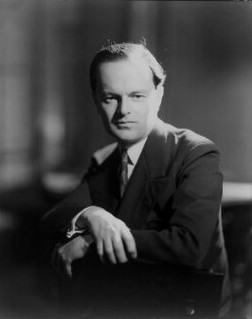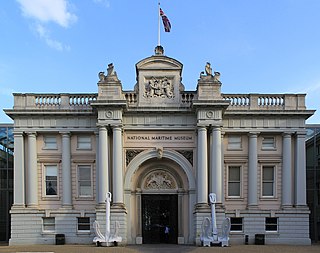Related Research Articles

Kenneth Mackenzie Clark, Baron Clark was an English art historian, museum director, and broadcaster. After running two important art galleries in the 1930s and 1940s, he came to wider public notice on television, presenting a succession of programmes on the arts during the 1950s and 1960s, culminating in the Civilisation series in 1969.

The National Maritime Museum (NMM) is a maritime museum in Greenwich, London. It is part of Royal Museums Greenwich, a network of museums in the Maritime Greenwich World Heritage Site. Like other publicly funded national museums in the United Kingdom, it has no general admission charge; there are admission charges for most side-gallery temporary exhibitions, usually supplemented by many loaned works from other museums.

Sir Antonio Genesio Maria Panizzi, better known as Anthony Panizzi, was a naturalised British citizen of Italian birth, and an Italian patriot. He was a librarian, becoming the Principal Librarian of the British Museum from 1856 to 1866.

Anthony Green was an English realist painter and printmaker best known for his paintings of his own middle-class domestic life. His works sometimes used compound perspectives and polygonal forms—particularly with large, irregularly shaped canvasses. As well as producing oil paintings, he also produced a number of works designed from the start as limited edition prints, which were typically giclée works.
Sir Charles Robert Saumarez Smith is a British cultural historian specialising in the history of art, design and architecture. He was the Secretary and Chief Executive of the Royal Academy of Arts in London from 2007 until he stepped down in 2018. He was replaced by Axel Rϋger, who took up the position in 2019.

Intaglio is the family of printing and printmaking techniques in which the image is incised into a surface and the incised line or sunken area holds the ink. It is the direct opposite of a relief print where the parts of the matrix that make the image stand above the main surface.

Sir George Clausen was a British artist working in oil and watercolour, etching, mezzotint, drypoint and occasionally lithographs. He was knighted in 1927.

The etching revival was the re-emergence and invigoration of etching as an original form of printmaking during the period approximately from 1850 to 1930. The main centres were France, Britain and the United States, but other countries, such as the Netherlands, also participated. A strong collector's market developed, with the most sought-after artists achieving very high prices. This came to an abrupt end after the 1929 Wall Street crash wrecked what had become a very strong market among collectors, at a time when the typical style of the movement, still based on 19th-century developments, was becoming outdated.
Dame Jessica Mary Rawson, is an English art historian, curator and sinologist. She is also an academic administrator, specialising in Chinese art.
Eileen Cooper is a British artist, known primarily as a painter and printmaker.

Paul V Coldwell is an English artist.

The British Museum Library: A Short History and Survey is a book by Arundell Esdaile published by George Allen & Unwin, London, in 1946. It was reprinted in 1979 by Greenwood Press, Westport, Conn. from the 1948 ed. published by G. Allen & Unwin, London, which was issued as no. 9 of the Library Association series of library manuals. Esdaile's book serves as a historical survey of the British Museum Library when the museum and library departments were housed in the same building. The book traces the entire history of the institution, from 1753 to 1945.

William Young Ottley was a British collector of and writer on art, amateur artist, and Keeper of the Department of Prints and Drawings at the British Museum. He was an early English enthusiast for 14th- and 15th-century Italian art, or the "Italian Primitives" as they were then often called. He spent the 1790s based in Rome, where he bought much art; this was sold for a considerable profit in 1801 after his return to London.
Sir James Gow Mann was an eminent figure in the art world in the mid twentieth century, specialising in the study of armour.
William Meriton Eaton, 2nd Baron Cheylesmore is best remembered as a leading collector of English mezzotint portraits, and collector of other art. His mezzotints and other prints, over 10,000 in number, were left to the British Museum, and five oil paintings to the National Gallery, London. He also stood unsuccessfully for Parliament for the Conservative Party at Macclesfield in 1868, 1874 and 1880, and held a nominal partnership in the family silk business.

Arthur Mayger Hind (1880–1957) was a British art historian and curator, who usually published as Arthur M. Hind or A. M. Hind. He specialized in old master prints, and was Keeper of the Department of Prints and Drawings at the British Museum until he retired in 1945.
The Panizzi Lectures are a series of annual lectures given at the British Library by "eminent scholars of the book" and named after the librarian Anthony Panizzi. They are considered one of the major British bibliographical lecture series alongside the Sandars Lectures at the University of Cambridge and the Lyell Lectures at Oxford University.
Jeffery Edwards is a British artist who was born in London in 1945.
Josephine Dawn Adès,, also known as Dawn Adès, is a British art historian and academic. She is professor emeritus of art history and theory at the University of Essex.
Leslie Elizabeth Webster, is an English retired museum curator and art historian of Anglo-Saxon and Viking art. She worked from 1964 until 2007 at the British Museum, rising to Keeper, where she curated several major exhibitions, and published many works, on the Anglo-Saxons and Early Middle Ages.
References
- 1 2 3 4 5 6 'GRIFFITHS, Antony Vaughan', Who's Who 2017 , A & C Black, an imprint of Bloomsbury Publishing plc, 2017; online edn, Oxford University Press, 2016; online edn, Nov 2016 accessed 5 Oct 2017
- 1 2 "Antony Griffiths (Biographical details)". The British Museum. Trustees of the British Museum. Retrieved 5 October 2017.
- ↑ "The British Library Panizzi Lectures 1985 -2014" (PDF). The British Library. Retrieved 5 October 2017.
- 1 2 "Antony Griffiths named Oxford Slade Professor for 2015". Art Fund. National Art Collections Fund. 26 January 2015. Retrieved 5 October 2017.
- 1 2 "Professor Antony Griffiths". The British Academy. Retrieved 5 October 2017.
- ↑ Pickles, Matt (9 January 2015). "Slade lectures 2015 announced: free talks on printmaking before photography". Oxford Arts Blog. University of Oxford. Retrieved 5 October 2017.
- ↑ "Home page". Print Quarterly. Retrieved 5 October 2017.
- ↑ "Meet our trustees". Art Fund. Retrieved 5 October 2017.
- 1 2 "Collections Online: Antony Griffiths". British Museum. Retrieved 5 June 2024.
- ↑ "Constitution and Governance". The Walpole Society. Retrieved 5 October 2017.
- ↑ "Our trustees". The Henry Moore Foundation. Retrieved 5 October 2017.
- ↑ "From Wikipedia to Roman coins: British Academy recognises excellence in the humanities and social sciences". The British Academy. Retrieved 5 October 2017.